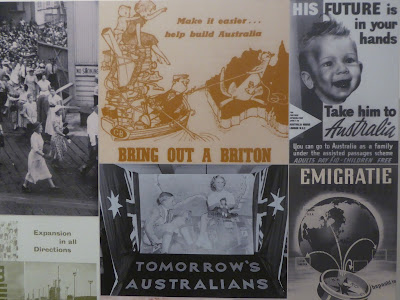 |
| Graffiti, Melbourne |
Our Airbnb was in a great location in Fitzroy, just off Brunswick Street. This was a carefully selected area, not too far from the centre, but right in the heart of the eating and drinking hub - and just around the corner from a really excellent cocktail bar.
You may have guessed that cultural and historical aspects of the city were not high on our list of things to do here!
 |
| Immigration Museum, Melbourne |
We did at least go to the Immigration Museum, which gave an interesting insight into how Australia has handled immigration over the years. When the Federation of Australia was formed in 1901, they brought in the Immigration Restriction Act, which was one aspect of the unofficial 'White Australia Policy' which sought to prevent the entry of any non white-European immigrants.
In the preceeding years, there had been actions to reduce the number of Chinese coming to work in the mining industry - not because they weren't good workers, but because they worked co-operatively, which made them more effective and therefore more successful, and the white Australian miners didn't like that.
 |
| Immigration Museum, Melbourne |
Now at the time, the UK was a little uncomfortable with the overtly racist approach of 'whites only', (albeit not so uncomfortable as to block it,) so Australia opted for a supposedly more subtle approach of introducing a dictation test which any non white-Europeans had to pass to gain entry. The museum had some examples of the fifty word test, and I can pretty much guarantee that there is a sizeable chunk of 'indigenous white' British people that wouldn't be able to pass it, let alone people for whom English is a second language.
 |
| Immigration Museum, Melbourne |
And the difficulty wasn't the only issue. The test could be done in any European language, chosen by the officials. So there are examples of people from Malta, with great English, being given the test in Dutch. One political activist, who was fluent in several languages, was denied entry for failing the test after being given it in Gaelic. This test was in use in Australia right up until 1958.
Asian migration to Australia only really began in the late 1960s, after the Labor Party removed the 'White Australia' policy from its platform.
 |
| Immigration Museum, Melbourne |
Some sources even suggest that, prior to these changes in legislation, Aboriginal people were in fact counted as part of the Flora and Fauna of Australia, rather than as people. This seems unlikely to be technically true, but the fact that this is still referred to is probably a good indication of how they were treated at the time.
 |
| Immigration Museum, Melbourne |
No comments:
Post a Comment
We like to hear from you too, so please leave us a message here. We are also happy to answer any questions if we can help. Comments are moderated so will not appear straight away and there could be some delay in replying if we are travelling.